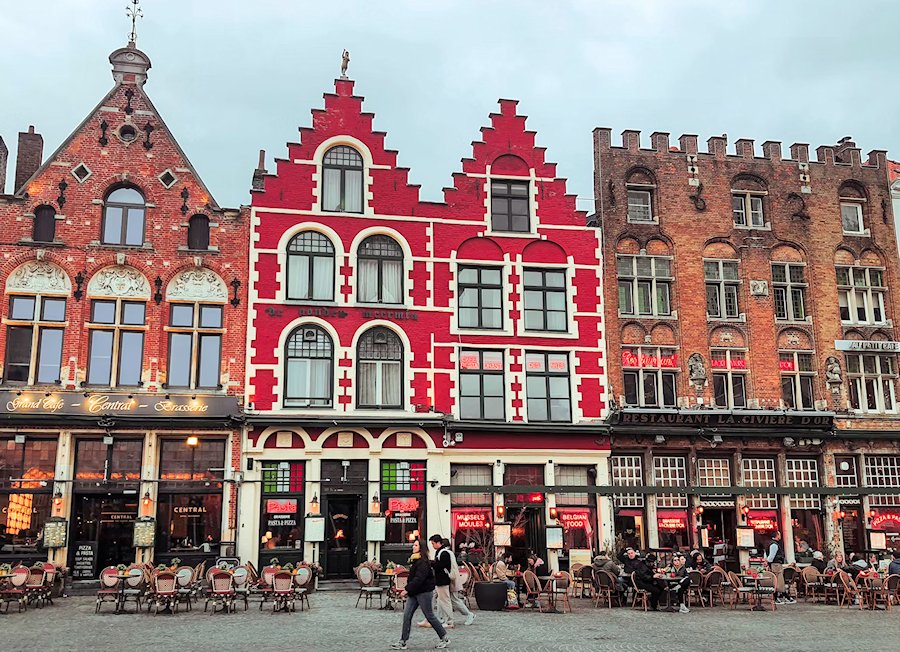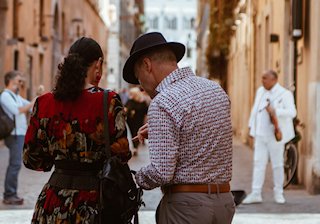Travel Notes: Destinations: Europe: Belgium - Bruges Travel Guide.
Short URL: https://tnot.es/OST
Travel Guide For Visitors to Bruges
Often referred to as a mini-Amsterdam, Bruges is famous for its well-preserved medieval architecture and canals; a living medieval masterpiece time forgot. Share on Facebook
How to Avoid The Crowds
While Bruges can be crowded during peak seasons, visiting the city in the off-season allows for a more peaceful experience.
 Add a Business -
Add a Location -
Add a Lodging - Add Travel Content
- Add URL
- Travel Services.
Add a Business -
Add a Location -
Add a Lodging - Add Travel Content
- Add URL
- Travel Services.
Travel Back in Time on a Visit to Bruges
Picture this: you're wandering down cobblestone streets that have barely changed since the 1300s, past gabled houses that look like they've been lifted straight from a storybook, while the gentle clip-clop of horse-drawn carriages echoes off ancient walls.
Welcome to Bruges, where fairy tales aren't just for children.
Often called the 'Venice of the North' (though frankly, it's got its own unique charm that doesn't need the comparison), this UNESCO World Heritage city in West Flanders is Belgium's most visited destination; and for a very good reason.
Whether you're a history buff, a chocolate fiend, or someone who simply appreciates jaw-dropping architecture, Bruges delivers all that and more.
Why Bruges is More Than Just a Pretty Face
A Medieval Time Capsule That Actually Works
Unlike many European cities that have been rebuilt countless times, Bruges' historic centre remains remarkably intact.
The city's golden age as a major trading hub during the 12th to 15th centuries left behind an architectural legacy that's nothing short of spectacular.
Today, you can walk the same streets that medieval merchants once traversed, admiring buildings that have witnessed centuries of history.
Size Matters - When It's This Perfect
Here's the brilliant thing about Bruges; it's compact enough to explore on foot, yet packed with enough attractions to keep you busy for days.
The entire historic centre spans just 430 hectares, making it ideal for a weekend break or a longer stay without feeling overwhelming.
When to Visit Bruges - Timing Your Medieval Adventure
Spring (April-May)
Arguably the sweet spot for visiting Bruges.
The weather's mild, flowers are blooming, and the crowds haven't reached summer levels yet.
Perfect for those Instagram-worthy canal shots without photobombing tourists.
Summer (June-August)
Warmest weather and longest days, but also peak tourist season.
Expect queues at major attractions and higher accommodation prices.
Book well in advance if you're planning a summer visit.
Autumn (September-October)
Fewer crowds, comfortable temperatures, and the city takes on a golden hue that's absolutely magical.
September is particularly lovely.
Winter Wonderland (November-March)
Don't dismiss Bruges in winter.
The city transforms into a Christmas card scene, complete with twinkling lights and festive markets.
Yes, it's chilly, but there's something incredibly atmospheric about exploring medieval streets in the crisp winter air.
Plus, you'll have many attractions practically to yourself.
Getting to Bruges - Your Gateway to Medieval Belgium
By Air
Brussels Airport (BRU), the main international gateway, is located about 100km from Bruges.
Direct trains run from the airport to Brussels, where you'll connect to Bruges; the total journey taking 1.5 to 2 hours.
Brussels South Charleroi Airport (CRL) is popular with budget airlines.
Take a bus to Brussels Central Station, then train to Bruges.
Driving ito Brugges s Possible but Problematic
While you can drive to Bruges, parking in the historic centre is limited and expensive.
Consider using one of the Park & Ride facilities on the outskirts and taking public transport into the centre.
Train Travel - The Civilised Option
Bruges is brilliantly connected by rail; and you don't have to worry about parking.
Direct Trains Run From
Antwerp: 1.5 hours - Brussels: 1 hour - Ghent: 30 minutes - London: 3.5 hours via Eurostar (change in Brussels).
The train station is about a twenty minute walk from the city centre, or take bus 1 or 11.
Must-See Attractions in Bruges - The Essential List
Basilica of the Holy Blood - Medieval Relic Central
This 12th-century basilica claims to house a vial of Christ's blood brought back from the Crusades.
Whether you're religious or not, the ornate interior and historical significance make it fascinating.
Church of Our Lady - Home to Michelangelo's Madonna
This Gothic masterpiece houses the only Michelangelo sculpture to leave Italy during the artist's lifetime.
The Madonna and Child is reason enough to visit, but the church's soaring brick spire (115 metres) is also worth craning your neck for.
Groeningemuseum - Flemish Masters Galore
Art lovers shouldn't miss this compact but impressive museum at Dijver 12, showcasing Flemish primitives including works by Jan van Eyck and Hans Memling.
It's manageable in size; perfect for those suffering from museum fatigue.
Market Square (Grote Markt) - The Beating Heart
This UNESCO-listed square is where every Bruges adventure begins.
Surrounded by guild houses with their distinctive stepped gables, it's been the city's commercial heart for over 1,000 years.
Don't Miss
The Belfry Tower.
Climb the 366 steps for panoramic views (if you can handle the claustrophobia-inducing spiral staircase).
Where to Stay in Bruges - From Boutique to Budget
Historic Centre - Maximum Charm, Maximum Cost
Staying within the UNESCO zone puts you at the heart of the action.
Expect to pay premium prices for the privilege of rolling out of bed into a medieval wonderland.
Luxury
Dukes' Palace Brugge (Prinsenhof 8), Hotel Heritage (Niklaas Desparsstraat 11).
Mid-range
Hotel Aragon (Naaldenstraat 22), Hotel Ter Reien (Langestraat 1).
Budget
Charlie Rockets Youth Hostel (Hoogstraat 19), Snuffel Hostel (Ezelstraat 42).
Just Outside the Centre - Best Value
A 10-15 minute walk from the main square can save you significant money whilst still keeping you close to the action.
Recommended areas: Near the train station, Minnewater area.
Tourist Map of Bruges
Use the Tourist Map of Bruges to help you decide where to stay in Bruges based on travel budget, preferred location, planned must-see attractions and local must-do activities.
Bruges Canal Tours - Seeing the City from Water Level
Taking a Canal Tour
The canals offer unique perspectives of Bruges' architecture and provide access to hidden corners you'd miss on foot.
Plus, it's rather nice to rest your feet after all that cobblestone walking.
Tour Options
Traditional Boat Tours
Thirty-minute guided tours departing from various points around the city centre (€14-16 per adult).
Evening Tours
Particularly atmospheric as the city lights reflect on the water.
Private Tours
More expensive but offer personalised experiences.
Top tip: Canal tours operate year-round but are weather-dependent in winter.
Bruges Food Scene - Beyond the Obvious
Belgian Beer - Liquid History
With over 300 Belgian beers available, Bruges is a beer lover's paradise.
Best beer bars: Café Rose Red, De Garre (hidden down an alley), 't Brugs Beertje.
Must-try locals: Brugse Zot (brewed in the city), Straffe Hendrik.
Chocolate - The Sweet Stuff
Yes, Bruges is famous for chocolate, but skip the tourist traps around Market Square.
Chocolatier Dumon - Family-run shop with exceptional pralines.
Sukerbuyc - Traditional sweets and chocolates.
The Chocolate Line - Innovative flavours from a master chocolatier.
Dining Beyond Tourist Menus
Casual Excellence - Bistro Refter, Café Vlissinghe (oldest pub in Bruges).
Fine Dining - De Vlaamsche Pot, Restaurant Vermeersch.
Local Specialities - Try carbonnade flamande (Flemish beef stew) and moules-frites.
Hidden Gems - The Bruges Locals Don't Want You to Know
Almshouses - Social Housing, Medieval Style
Scattered throughout the city, these historic housing complexes for the poor and elderly offer glimpses into medieval social welfare.
Many are still inhabited today.
Begijnhof - Peaceful Refuge
This tranquil courtyard of white houses was once home to the Beguines, a semi-religious community of women.
Today, it's occupied by Benedictine nuns and offers a peaceful escape from the tourist crowds.
Minnewater (Lake of Love) - Romantic Nonsense That Actually Works
Despite the cheesy name, this small lake on the city's southern edge is genuinely lovely, especially at sunset.
The surrounding park is perfect for a peaceful stroll.
Windmills on the City Walls - Unexpected Industrial Heritage
Four historic windmills dot the city's ancient ramparts.
Sint-Janshuismolen still operates and offers tours, providing insight into Bruges' industrial past.
Day Trips from Bruges - Expanding Your Belgian Adventure
Antwerp (1.5 hours by train)
Antwerp, Belgium's second city, combines medieval charm with contemporary culture.
The diamond district, fashion scene, and impressive cathedral make it worth the journey.
Brussels (1 hour by train)
Brussels, the capital of Belgium, deserves more than its reputation suggests.
Beyond EU institutions, you'll find Art Nouveau architecture, world-class museums, and yes, excellent beer and chocolate.
Damme (8km by bike or bus)
This tiny medieval town makes for a perfect half-day excursion.
Cycle there along the tree-lined canal for maximum charm.
Ghent (30 minutes by train)
Less touristy than Bruges but equally impressive, Ghent offers stunning architecture, excellent museums, and a more authentic local atmosphere.
Practical Tips for Visiting Bruges
Essential Bruges Etiquette
Canal Tours - Don't lean over the sides dramatically for photos.
Cycling - Ring your bell to warn pedestrians.
Queuing - Do it properly; this isn't a free-for-all.
Restaurants - Book ahead, especially for dinner.
Getting Around Bruges
Cycling - Excellent bike rental options, but watch for cobblestones.
Public Transport - Efficient bus system connects outer areas.
Taxis - Available but expensive for short distances.
Walking - The historic centre is entirely walkable.
Language
Official - Dutch (Flemish).
Tourist Reality - English is widely spoken in tourist areas.
Useful Phrases - "Dank je wel" (thank you), "Spreekt u Engels?" (Do you speak English?).
Money Matters
Cards - Widely accepted, but carry some cash for smaller establishments.
Currency - Euro (€).
Tipping - 10% is appreciated but not expected.
Shopping in Bruges - Beyond the Chocolate Shops
Beer - Liquid Souvenirs
Take home a taste of Belgium.
Bacchus Cornelius (Academiestraat 17) - Specialist beer shop with expert advice.
Lace - The Traditional Choice
Bruges lace has been famous since the 15th century.
Lace Centre (Balstraat 16) - Museum and shop combination.
't Apostientje (Balstraat 11) - Traditional handmade lace.
Unique Finds
Callebert - Traditional Belgian comics.
Het Mosterdzaadje - Artisanal mustards and preserves.
Rombaux - Musical instruments in a medieval setting.
Bruges with Children - Family-Friendly Medieval Fun
Kid-Approved Attractions
Canal boat rides: Most children love being on the water.
Choco-Story Museum: Interactive chocolate-making demonstrations.
Frietmuseum: Yes, a museum dedicated to chips; surprisingly engaging.
Horse-drawn carriages: Fairy-tale transport that delights young visitors.
Practical Family Tips
Family restaurants: Many offer children's menus and high chairs.
Playgrounds: Several parks offer play areas for energy-burning.
Pram-friendly: Cobblestones can be challenging; consider a baby carrier.
Bruges After Dark - When the Day Trippers Leave
Cultural Evening Events
Concerts: Regular performances in historic venues.
Festivals: Seasonal events throughout the year.
Theatre: Local productions (usually in Dutch).
Evening Atmosphere
Once the day-trippers depart, Bruges transforms.
The streets become quieter, the lighting more atmospheric, and locals reclaim their city.
Nightlife Options
Cosy pubs: Perfect for beer tasting and conversation.
Live music: Several venues offer everything from jazz to contemporary.
Night walks: The illuminated buildings create magical evening strolls in Bruges.
Sustainable Tourism in Bruges - Being a Responsible Visitor
Environmental Considerations
Local products: Support regional producers.
Walking and cycling: The most sustainable way to explore.
Waste reduction: Carry a reusable water bottle.
How to Visit Responsibly
Respect Residents - Remember people actually live here.
Stay Longer - Reduces transport emissions per day visited.
Support Local Businesses - Choose independent shops and restaurants.
Use Public Transport - Reduce traffic congestion.
Visit off-season - Help spread tourist load throughout the year.
Overtourism Challenges
Bruges receives over 8 million visitors annually; that's a lot of pressure on a small medieval city.
As a responsible traveller, you can help minimise your impact.
Planning Your Bruges Itinerary - Making the Most of Your Time
One Day in Bruges - The Greatest Hits
Morning - Market Square and Belfry Tower.
Midday - Canal boat tour.
Afternoon - Church of Our Lady and Groeningemuseum.
Evening - Beer tasting and dinner.
Two Days in Bruges - More Depth
Day 1: As above.
Day 2: Begijnhof, windmills, Choco-Story Museum, evening stroll.
Three Days in Bruges - The Full Experience
Day 1-2: As above.
Day 3: Day trip to Ghent or cycling to Damme, artisan workshops.
Week in Bruges - Deep Dive
Perfect for slow travel enthusiasts who want to truly understand the city, including day trips to Brussels, Antwerp, and the Belgian coast.
Bruges Weather - What to Expect
Climate Overview
Bruges has a temperate maritime climate.
Think mild summers and cool winters with the possibility of rain year-round.
Monthly Breakdown
Best weather: May to September.
Coldest: December to February (average 3°C).
Warmest: July to August (average 18°C).
Wettest months: October to January.
Packing Essentials
Comfortable walking shoes - Cobblestones are unforgiving.
Layers - Weather can change quickly.
Rain jacket - Essential year-round.
Umbrella - For those inevitable Belgian showers.
Why Bruges Should Be on Your Travel List
Bruges isn't just another European city break destination; it's a journey back in time that somehow feels entirely relevant to the present.
Yes, it can be crowded during peak season, and yes, some areas feel touristy, but step away from the main drags and you'll discover a living, breathing medieval city that has managed to preserve its heritage whilst embracing modernity.
The magic of Bruges lies not just in its stunning architecture or excellent beer (though both certainly help), but in the way it makes you slow down.
In our fast-paced world, there's something profoundly calming about wandering streets that have remained largely unchanged for centuries, where the biggest rush hour involves horse-drawn carriages and the most pressing decision is which chocolate shop to visit next.
Whether you're planning a romantic weekend, a family adventure, or a solo exploration of one of Europe's best-preserved medieval cities, Bruges delivers an experience that's both deeply historical and thoroughly enjoyable.
Just remember to bring comfortable shoes; those cobblestones wait for no one.
More City Travel Guides
City Guides: Cities in Africa - Cities in America - Cities in Asia - Cities in Australasia - Cities in Latin America - European Cities and Regions.
More From Travel Notes
Travel Notes Online Guide to Travel
Africa - Asia - Caribbean - Europe - Middle East - North America - Oceania - South America.
The Travel Notes Online Guide to Travel helps visitors plan their trip with country and city travel guides, local tourist information, reviewed web sites, and inspiring travel content.
Travel and Tourism Guides on Travel Notes
 If you find Travel Notes useful, please take a moment to
like us on Facebook and share with your friends on social media.
If you find Travel Notes useful, please take a moment to
like us on Facebook and share with your friends on social media.
Share on Facebook
Travel Resources
.
Travel & Tourism With Industry Professionals.















